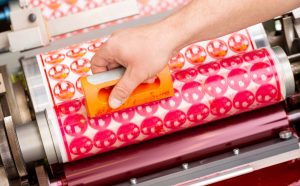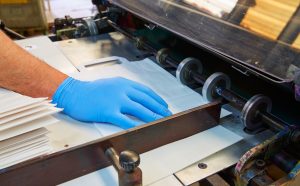Evolution of Flexographic Printing
Flexographic Printing Evolution
Flexographic printing dates to the original letterpress printing press process. Previously, this printing process used a metal mechanical press to print letters with ink. This revolution paved the way for mass printing production.

However, the original printing press was inconsistent, slow, and not precise. Instead of pressing two flat surfaces together, rolling cylinders created the rotary letterpress process. From there, flexography emerged as people began wrapping synthetic rubber plates around these cylinders. Now, modern flexographic printing utilizes flexible photopolymer printing plates.
What is Flexographic Printing?
Certainly, flexographic printing is one of the world’s most standard printing methods. That is to say, it produces high-quality results efficiently. Importantly, flexo printing facilitates custom label printing at very large volumes.
In short, flexographic printing utilizes a flexible relief plate to print high-resolution images on a variety of substrates. Therefore, companies choose flexo printing because of its optimal productivity and flexible options.
The Process of Flexographic Printing
1. Artwork Design
Firstly, clients will present their desired label design. They may already have their artwork prepared. Optimized graphics are needed for the process. Any spot colors required must be built into the design. It is necessary to thoroughly proof your artwork file prior to printing. This will avoid costly mistakes.

2. Choose Substrate Material
Secondly, it’s time to pick your substrate material. In other words, choosing a material that meets your custom product label specifications is crucial. These can vary by the industry for example food products may require additional material barriers to eliminate contamination. From gift wrap to stand-up pouches to plastic bottle wrap, the options for flexographic printing are endless.
3. Feed into the Flexographic Printing Press
With your design and printing materials ready, it’s time for the custom label printing magic. From the ink tray to the anilox roller, ink is transferred to the plated image. As the stock unwinds from the roll, the substrate presses against the plate to transfer the image. Overall, this continuous printing process is rapid and produces efficient results.
4. Drying & Finishing
The substrate then runs through a plate-less portion of the flexographic machine to dry the resulting surface at each ink/print station. UV, LED lamps, or hot air dryers are used to cure a variety of inks that are water, oil, LED, or UV based that facilitate quick drying. Lastly, the substrate is transferred to a die station to cut to size.
Flexographic Printing Applications

Flexographic printing is applicable to a range of custom label printing products. Its efficient output makes flexo printing suitable for large orders. Also, flexographic printing is undoubtedly ideal for custom label printing because it fits any item’s packaging. There is no limitation to the packaging’s shape, size, or color.
Another advantage of flexographic printing is that it can use a wide range of materials. Flexo printing applies to most packaging. For instance, paper, plastic, foil, cardboard, film composites, and non-woven fabrics work great.
Pros and Cons of Flexo Printing
All in all, the advantages far outweigh the disadvantages of flexographic printing. But it is still useful to consider both sides.
Pros:
- High-volume printing production
- Prints on a variety of substrate materials
- Reasonable cost with a high return on investment
Cons:
- Can be time-consuming and an additional expense to alter your design
Why Choose Kwality Labels Inc for Your Flexographic Needs?
Here at Kwality Labels, we aim to bring your custom label artwork to life. We know how crucial it is to win the shelf. That’s why we use high-quality tools to exceed expectations.
Our team of experts pays close attention to details and accuracy from prepress through to shipping. We strive to get your custom labels printed right. For label printing, consider GTA Toronto-based Kwality Labels as your printing professionals.
To learn more about how we can serve your custom product printing needs, check out our range of products or contact us with any questions you may have. We look forward to working with you.

